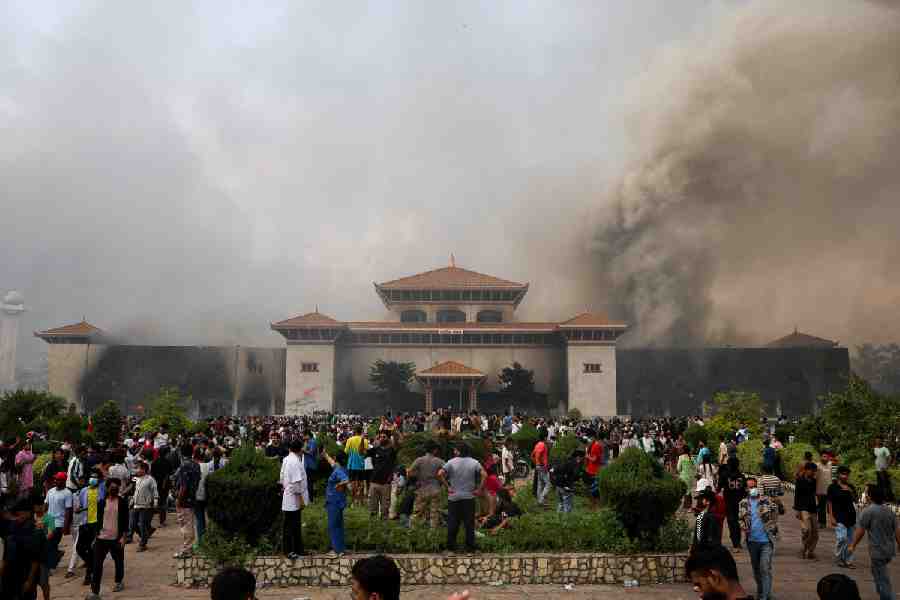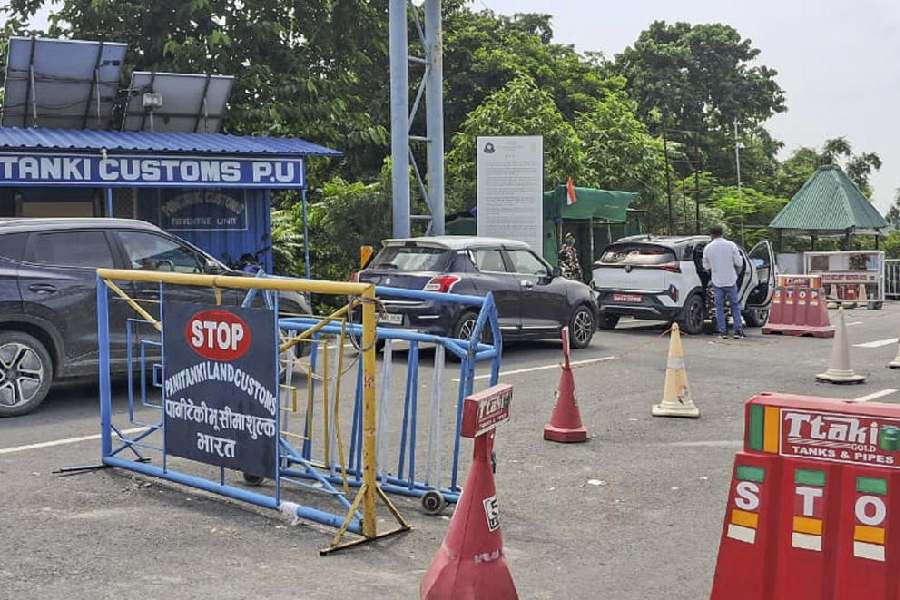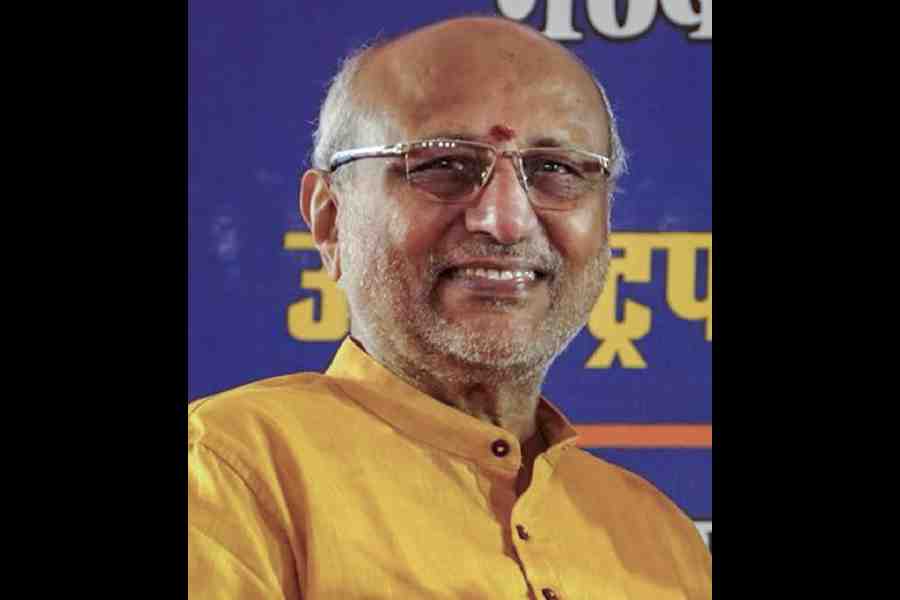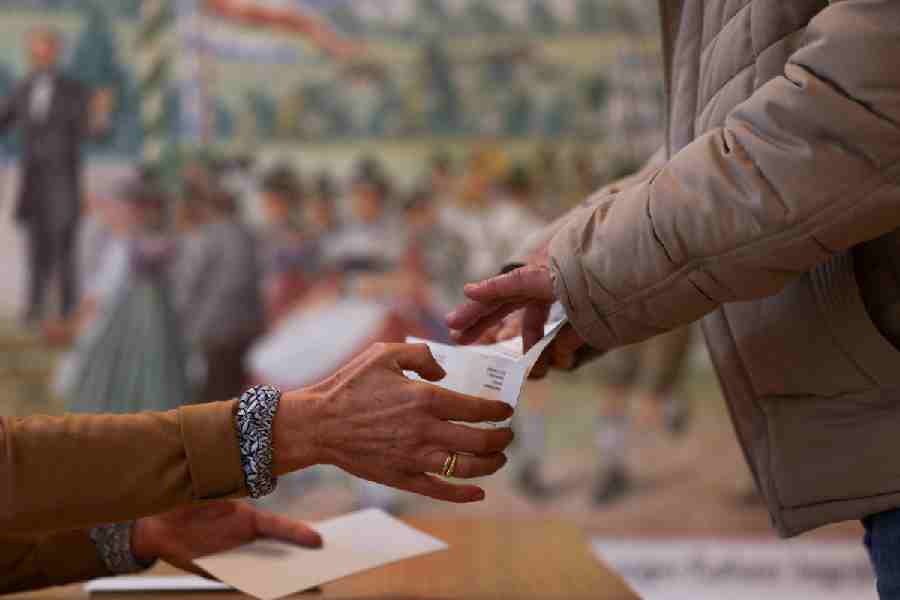 |
| Different take: Forbes insists that Indian women in the last century were not mere marionettes; her well-known tome (below) |
A mirror and a woman. You can see a glorious black mane tumbling down a slim sari-clad back. In the golden glow of the hazy sunlight bouncing off the mirror, she seems fully engrossed in herself. And beyond the curved bed poster, another pair of eyes is obviously engrossed in looking at her. There’s a wealth of adoration in that gaze, you feel. Even 76 years after Suniti Sarkar — the young wife of an amateur Calcutta photographer in the Twenties — was caught unawares on camera by her husband, the faded grains have not taken that loving look away.
“Read this photo for me,” invites Geraldine Forbes. Clad in a casual salwar-kameez, she’s sitting on the floor of her Cornfield Road flat in south Calcutta. A laptop on her knees and a coffee mug on the pouffe next to her. “The camera has a loving gaze ...” you offer tentatively. She takes you up on that: “Doesn’t it! He was, apparently, crazy about her hair. And even on her deathbed, years after he had died, she refused to have it cut. The romance that strikes you in the photo, actually, documents a time when men and women had started ‘talking’ to each other as partners. Suniti and her husband had known each other for long before tying the knot. It was a pretty ‘modern’, companionate marriage.”
Forbes gets busy fishing out photographs (some 2000-plus) of women stored in her digital archive. “Gotcha!” she gives a triumphant grin. A black-and-white photograph of a woman in a Marathi-style sari pops up on the screen. No, this cannot be a housewife, you tell her. Not with that expression on her face. “It’s actually a man,” she shrieks with laughter. “He used to do women’s roles on the Marathi stage, and set fashion trends for women in the late 19th century.”
You marvel at it all. At the range of photographs of women, born between 1899 and 1910, from all over India (“The generation that took the first baby steps into the public domain”), painstakingly collected from family albums over two decades. And at the person who has taken up the arduous task of “telling” their story (“Photos don’t speak for themselves. But if you look closely enough at the details — who wore what, how they posed, what was the occasion, who took the photograph, what else is there in the frame — stories emerge. And women come out as individuals, with personalities. Not simply as ornaments”).
Visions of library racks and bright blue spines of the New Cambridge History Of India series float up. For most students of history, the favourite pick in that morass of dates and data, is inevitably the slim volume: Women In Modern India. Hardly a wonder, then, that its author, Geraldine Forbes, the ‘distinguished professor’ at State University of New York, Oswego, should be a sort of a household name here. Just as it doesn’t come as a surprise that the scholar who once insisted that Indian women in the last century were not simply “marionettes” controlled by men, would again be working at recovering their “voices” from old photographs.
It was a chance meeting with “a sweet little woman” that triggered off the whole thing. Forbes had come to Calcutta to do a spot of research on positivism in Bengal, way back in the Seventies. There wasn’t much in the libraries and as she got passed around from family to family in search of information, word came to her that a relative of one of Bengal’s early positivists was the person to get in touch with (“She’s the family historian, they said”). Shudha Mazumdar had been a Bengal civil servant’s wife and deeply involved with voluntary organisations for women’s uplift at one time. “We became very good friends,” recalls Forbes, “and as we leafed through her family albums, memories were triggered off and out came untold stories”.
Mazumdar had been married off at 16 and, unlike women in the previous generations, she had followed her husband to every remote place he was posted in. “She was an educated city girl from a full and happening joint family,” points out Forbes, “and marriage threw up a challenge”. On the one hand, running a household with a bevy of servants, not having any work or anyone to talk to, got on her nerves. She took to writing to escape boredom. On the other hand, there was the realisation that her life was quite unique: as the mistress of a nuclear household and as a bureaucrat’s wife (“She showed me her photograph in riding breeches”).
Far from feeling ‘trapped’, Shudha Mazumdar unfolded as someone enthusiastically interested in the new things happening all around her, and aware that her generation was going through an uncharted experience, unthinkable to the previous. Women were going to schools and colleges, entering the professions, taking part in politics, travelling and floating social organisations. “I realised that life was a whole new ball game to these women,” says Forbes, “It was with this sense of living in a special time that Shudha started to jot down her memoir. And she gave it to me.”
Forbes was struck by this “sense of living in special times” in a number of women born during this time. “So many women told me that they had the idea that their lives were important and should be documented,” she exclaims. Some would gladly give her their memoirs, others would show her photographs taken at ‘special’ moments (“In a Chennai family album, I chanced upon the snap of a woman taken as she was being released as a political prisoner from jail”) and tell her behind-the-scenes stories. “I began to see things differently,” asserts Forbes.
Parul Sarkar, born in 1899, showed a picture of her school days. The memory that accompanied it was of how she used to go to a convent school with her hair loose and get turned out of class regularly. “Nobody in my family would tolerate tying of wet hair,” Sarkar had laughed. “Nor would the nuns. It was unhygienic and the height of indiscipline to them. Such a trauma it was for me!” The more Forbes explored photographs, the more she came across slices of women’s lives in transition: little girls in Western clothes playing with toys meant for boys (“cars to balls”); young women in intimate (“for that age”) poses with their husbands, ‘showing’ photographs of girls of marriageable age (“passed on to families and friends discreetly”); women with children (“celebrating motherhood?”). And she began to perceive a progression in “the idea of what is a modern woman”.
The story Forbes is trying to capture, wouldn’t have been possible without the passion that photography had generated among gentlemen of that time. Studios had flourished in some parts of the country by the 1870s. And the educated, Westernised men, particularly in Bengal and Bombay, were experimenting and exhibiting photographs with a new vim and vigour. “It was as if they were trying to recreate their family history through these,” points out Forbes. “And the way a woman was depicted in the pictures — in traditional dress with bare feet or in modern clothes surrounded by material possessions — said much about the subjects,” she explains. The stories people tell with photography, don’t, necessarily, become formal accounts of their lives. But photographs can trigger memories of things that are rarely captured in the frames.
And therein lies the historian’s treasure trove.










